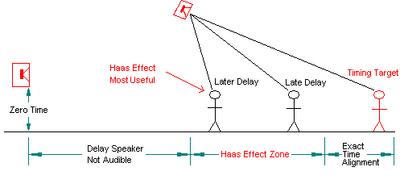What is the "Haas Effect"?
Over the years I have heard dozens of theories from dozens of audio technicians about the "Haas Effect". Some have merit. Some just sound like a wild guess. Lets start with the official definition as published in December, 1949:
Haas Effect Also called the precedence effect, describes the human psychoacoustic phenomena of correctly identifying the direction of a sound source heard in both ears but arriving at different times. Due to the head's geometry (two ears spaced apart, separated by a barrier) the direct sound from any source first enters the ear closest to the source, then the ear farthest away. The Haas Effect tells us that humans localize a sound source based upon the first arriving sound, if the subsequent arrivals are within 25-35 milliseconds. If the later arrivals are longer than this, then two distinct sounds are heard. The Haas Effect is true even when the second arrival is louder than the first (even by as much as 10 dB.). In essence we do not "hear" the delayed sound. This is the hearing example of human sensory inhibition that applies to all our senses. Sensory inhibition describes the phenomena where the response to a first stimulus causes the response to a second stimulus to be inhibited, i.e., sound first entering one ear cause us to "not hear" the delayed sound entering into the other ear (within the 35 milliseconds time window). Sound arriving at both ears simultaneously is heard as coming from straight ahead, or behind, or within the head. The Haas Effect describes how full stereophonic reproduction from only two loudspeakers is possible. (After Helmut Haas's doctorate dissertation presented to the University of Gottingen, Gottingen, Germany as "Über den Einfluss eines Einfachechos auf die Hörsamkeit von Sprache;" translated into English by Dr. Ing. K.P.R. Ehrenberg, Building Research Station, Watford, Herts., England Library Communication no. 363, December, 1949; reproduced in the United States as "The Influence of a Single Echo on the Audibility of Speech," J. Audio Eng. Soc., Vol. 20 (Mar. 1972), pp. 145-159.)
I will take this definition one step farther to explain how this phenomena can be applied to timed delay speakers in a venue.
Practical Application
When an audio technician measures and sets the timing for a delay speaker his time setting is only exact for one measured distance from the stage. At this location the listener will hear sound from the main speaker and the delay speaker at the same moment in time. These speakers are "Time Aligned". However, as the listener moves forward or back from this location the time alignment between the two speakers changes slightly by as much as five or ten milliseconds. This happens because as the listener walks one foot towards the main speaker he will only be, perhaps, 1/2 foot closer to the delay because he is approaching the delay at an angle. So, although the listener has shortened his distance/time to the mains by almost a millisecond he has only changed his distance/time from the delay speaker by half a millisecond. Walk ten feet towards the stage and the offset between the main speaker and delay speaker will be about 5 milliseconds. What this means is that at this position the sound from the delay speaker is reaching the listener 5 milliseconds later than the sound from the main speaker.
To some technicians this timing shift is seen as a problem that just can't be fixed. For others, they will tweak the system to make it less noticeable by playing with relative volume and offset timing until the systems sounds as natural as possible. Additional tweaking is certainly the right approach. And quite often the additional tweaking will result in a perfectly aligned system with the help of "The Haas Effect".
Three Easy Steps
1. We need to pick the correct spot to set the exact time alignment for the delay speaker. Typically this spot would be near the farthest coverage area of the delay. The last few rows of seats. The farthest area before you get into the next delay zone. Set your analyzer mic at this spot and use your tool (Smaart, TEF, SIM, ears) to set the time delay exactly on time.

2. After the delay time has been set, walk back to notice where the sound begins to drop off. This should happen at the outer edge of the delay's coverage area. If not, adjust the delay amp level accordingly. Use your equalizer to adjust the speaker to the room and test and adjust the speaker volume again so that the delay speaker volume is just a little louder than the sound from the mains, maybe 3 to 6 decibels. Since the two speakers are exactly time alligned the delay speaker should hardly be noticable.
3. Now that the delay time and delay level has been set, walk forward into the "Haas Effect Zone" and notice that the volume coming from the delay is getting louder. Of course, at the same time, the relative delay time is also getting longer. This is where the psychoacoustic properties of The Haas Effect come into play... More to come!
Friday, February 28, 2014
Time Alignment & The "Haas Effect"
===== Creation of this paper is still in progress =====
Labels:
Haas Effect,
Time Alignment
Subscribe to:
Post Comments (Atom)




No comments:
Post a Comment